
A retail sales cosmetic counter at The Barbie Flagship Store in Shanghai China. Photo Copyright ©2009. All Rights Reserved.
Interview: All Dolled Up
January, 2010 by Dr. Jane Haile at Gendercentric.org, Brussels Belgium.
Thank you for the opportunity to be part of Gendercentric. My professional background is working as a university lecturer and new media artist. Since 1999, I have been living and teaching in Asian countries ranging from highly industrialized countries like Japan to ‘South’ countries like Vietnam and Thailand. I have created a good network with regional artists, educators, and NGOs in the Asian region, which has opened the doors to some unique insights related to cultural and social issues. Currently, I’m living in Shanghai China.
Gendercentric: Can you explain what you mean by a ‘doll’ particularly in the context of your thesis, & why this interests you?
WFS: For me a ‘doll’ represents a ‘becoming’ or ‘embodiment’ of the perfect or ideal representation of our self, including anthropomorphous forms. As you can see this topic can include a diverse range of social issues from cosmetic surgery, the abolition of death, cloning and artificial intelligence, to utopia becoming a plastic product. Initially, my interests came from art and media uses and representations of our bodies or body fragments, and the dynamics associated with related social experiences. The doll can take many shapes or forms and be used for any purpose, i.e., our heroes/heroines, toys, pop idols, sex partners, avatars and more.
Throughout western art history we can observe the role the ‘doll’ has played from Pygmalion’s stone sculpture of a perfect woman, which is then brought to life through a love projection, to Surrealists themes in the early nineties—mannequins, dolls, body fragments, automaton, wax figures. There are a number of current artists that have created a visual language with the ‘doll’ motif including: Katrin Freisager, Kirsten Geisler, Lynn Hershman, Inez van Lamsweerde, Victorine Müller, Yves Netzhammer, Tony Oursler, Cindy Sherman, Judy Fox, Robert Gober, Mike Kelley, Kiki Smith.
More recently, cyberspace offers us the opportunity to build our own personalized avatars for online games and social networking sites. Cosmetic surgery has become popular and relatively inexpensive, especially in Asian countries like South Korea and Thailand, motivating people to change their physical appearance and creating a new medical tourism market. Japan is well known for ‘Cosplay’ (costume play), in which people dress up and act as their favorite animation character from comics and movies. Companies in the USA and Germany are producing expensive yet realistic sex dolls that are becoming substitutes for partners. In the pornography industry more and more of the models and actors with completely shaven pubic hair is common. Could this be a Barbie and Ken enactment?
As you can see from above, there are numerous issues to explore. I feel that talking about the ‘doll’ offers the best option for opening a dialogue for those who are interested, or confused about contemporary social issues related to the use of images in art and media.
Gendercentric: Will you be discussing different kinds of dolls & their functions? Traditionally girl dolls have been the traditional toys for girls, many of them being substitute babies with substitute houses & furniture but things are no longer so simple. We have Barbie & Ken of course? Are male dolls intended for boys?
WFS: I will be writing a formal analysis based on the politics of bodies, sexuality as an artificial process, artificial intelligence, humans as artifact, object as human as object, and other issues related to contemporary society. Besides key philosophical theories, there will be case studies, which include discussion of ‘dolls’ and issues that were previously raised above. Based on my findings and academic work, I would like to produce a non-academic book for main-stream audiences.
I think it is quite common for boys to play with ‘dolls’. As a child, I had many GI Joe male dolls, and what was later called action figures (for marketing reasons). I did think it was very strange that both male and female dolls were basically castrated. Even at a young age, children are aware of bodily differences.
A recent trend with toy companies like Mattel, Inc.—the company behind the ‘Barbie’ doll, is the mixing and blurring of our reality with fantasy by promoting their toys as a lifestyle. I noticed this trend in Asia since 2005-06 at a number of publicity events at shopping centers and department stores in Shanghai and in 2008-09 in Bangkok.
For example, Barbie teamed up with MAC—a cosmetic company, and produced its own line of make-up called ‘Barbie Loves MAC’. At the event, there were both male and female models highly stylized to appear as Barbie and Ken dolls. (see photo) They astonishingly resembled live plastic dolls. In addition, a set was designed that replicated a life size Barbie doll bedroom including the mirror. People were encouraged to come into the set and experience becoming ‘Barbie’ or ‘Ken.’
This was a highly successful event and well received in Shanghai so Mattel shortly there after created the first worldwide flagship ‘Barbie’ store. This store is not about buying toys rather it’s about becoming ‘Barbie.’
“Step into the glamorous Barbie® Shanghai Flagship Store, and enter a world where you can experience the ultimate Barbie® fantasy. From incredible shopping to the interactive design center, it’s a place where girls can be girls and where dreams really do come true!”
The Barbie Store Includes:
Design Center Girls can be a fashion designer for a day and create their very own Barbie® doll.
Fashion Runway Experience a real runway show featuring fashions from world-renowned designers.
Photo Moment Relive the magic of the day with an exclusive photo featuring you and Barbie®.
Barbie® SPA Reward yourself with a dream day of pampering and relaxation at our full-service day spa.
Everything Girl What’s a day without shopping? Power up the pink with girls’ clothing, shoes, accessories, and more.
The Barbie Phenomenon is far from over. Now, more and more companies are turning to Social Influence Marketing otherwise known as SIM. Through the use of SIM, Mattel’s Barbie is continuing to be rewarded for its efforts by increasing revenues. You can see Mattel’s approach by visiting their blog at: http://alldolldup.typepad.com/
Another doll that is particularly popular today is the Blythe Doll. Originally, Blythe Dolls were created in 1972 by the American company Kenner Products—now Hasbro. The doll actually failed in the USA market the same year it was launched. It was pulled from store shelves because it was deemed “too scary for children.”
More recently a Japanese company, CWC and TAKARA in 2001 (now TAKARATOMY), bought the rights to produce and redesigned the doll. Blythe Dolls became an overnight success based on a TV commercial produced for PARCO—a well known department store in Tokyo and other cities in Japan.
The redesign brought us the NEO Blythe with categories of doll types like Excellent, Superior, and Radiance, as well as names such as Darling Diva, Cassiopeia Spice, Ice Rune, and Urban Cowgirl. Also, there is a ‘Petitie’ line with names, like Little Retro Mama and Baby Rose. The features of the dolls are very similar to anime or cosplay (costume play) characters in Japanese animation movies and comics. They have oversized heads and big eyes on a miniature body. The eyes are interchangeable with a variety of colors and can be positioned to the left or right and appear slightly down or submissive. There are numerous accessories from schedule books to toothbrushes.
Blythe has a range of looks including Pure, Punk, and Gothic, or you can mix the styles as Punthic or Pure Punthic. The 12-inch tall diva has been celebrated in the front windows of Bloomingdales; on the cover of Women’s Wear; Daily on VH1’s I Love the ’70s; People Magazine; New York Times; and ad campaigns for Nordstrom, Sony, and trendy Japanese department stores. Becoming a Blythe Doll is possible today as its fashion and style have found its way into the leading design houses, including John Galliano, Prada, Gucci, Vivienne Westwood, Issey Miyake, Versace, Sonia Rykiel, and many others. Let the ‘doll’ be your guide. Come along and find your inner Blythe.
Gendercentric:Recent years have seen the growth in popularity of celebrity dolls… I guess the Obama’s are the latest. How do you see that trend?
WFS: The collecting phenomenon is an issue that I do not focus on in my current academic writings however, I have made notes of the popularity of certain types of dolls like the political ones.
Gendercentric: Dolls have an interesting connection with some types of religion & black magic e.g. voodoo dolls…. … will you be going there….. are Christian religious relics & statues ‘dolls’ in your sense?
WFS: Definitely. Religious statues are dolls as far as I am concerned. They represent a bridge toward the supernatural, and infinite existence that is beyond our reality. A great fantasy to envision we could live forever in some form beyond what we know. Again, we see the reverse of the death drive and more examples of utopian forms. I guess we could say it’s similar to wishing we could become superheroes when we were children.
Gendercentric: Thank you so much for sharing your ideas, William. We’ll be looking forward to seeing more of you on these pages as your work progresses.
Thank you for the opportunity to discuss my work with you.
See: Becoming Doll
Cosplay Event
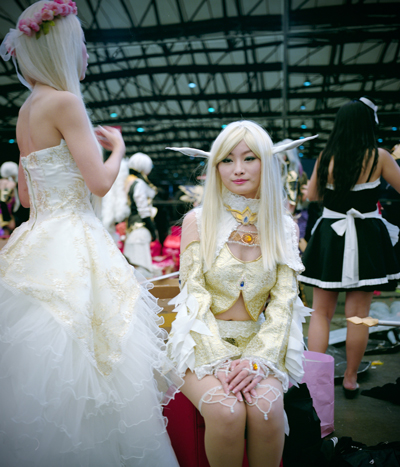
Shanghai, China. July 2009.
Two young Chinese participants before the event begins. Cosplay is a type of Japanese performance art whose participants outfit themselves, often with elaborate costumes and accessories, as a specific character from Japanese and East Asian comics or movies, including Manga, Anime, Tokusatsu, comic books, graphic novels, video games, and fantasy movies. Cosplay performance has become an overnight success in China, especially among young people. More and more are following a trend of creating their own identity through fashion and costume play. Photo by Daniele Mattioli © 2009
Barbie Loves MAC
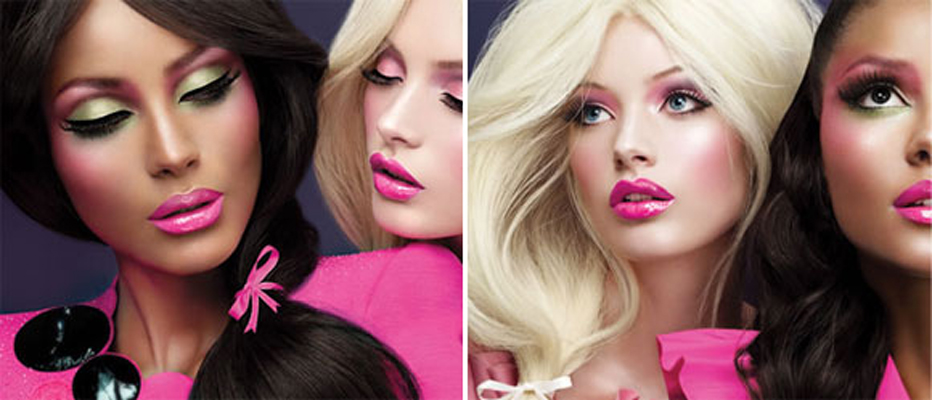
Look Closely. These are not dolls; however, real life Models stylized with the Barbie® Loves MAC cosmetic line. Photo from Barbie® website.
Shanghai Barbie Store
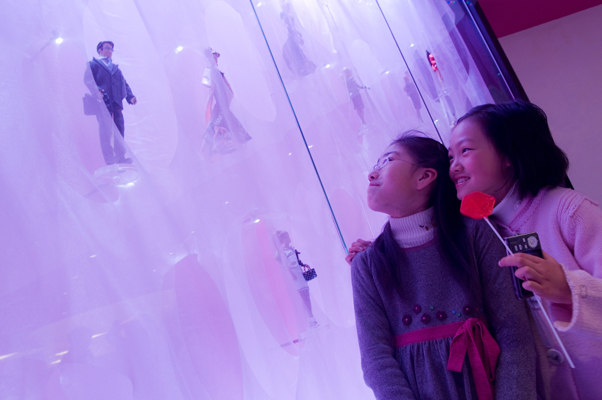
Two Young Chinese Girls gazing at Ken Doll at Barbie® Flagship Store in Shanghai China. Photo by Daniele Mattioli © 2009
Blythe Doll

Cosplay Participant
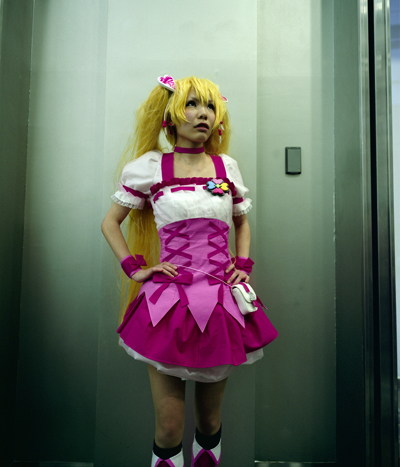
Shanghai China. Photo by Daniele Mattioli © 2009
Anikora
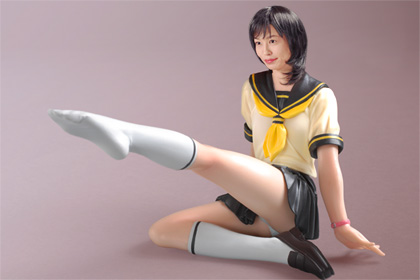
See: Anikora by Ryoko Suzuki © 2009